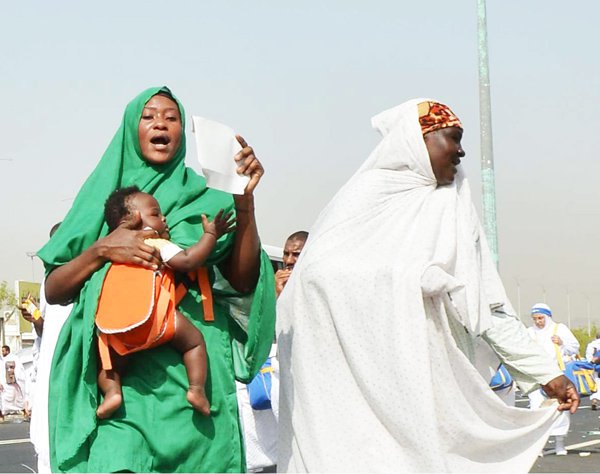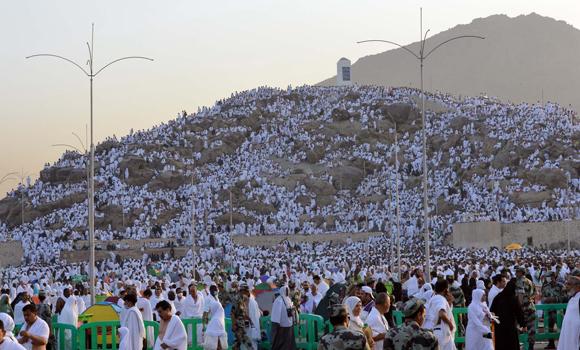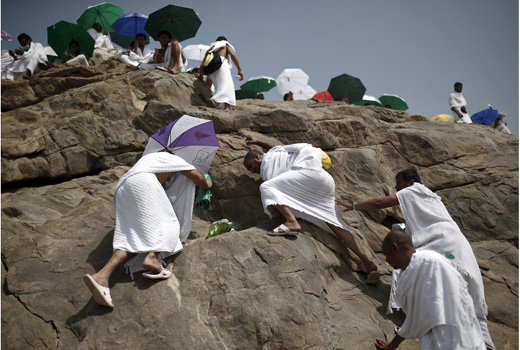www.aljazeerah.info
Opinion Editorials, September 2015
Archives
Mission & Name
Conflict Terminology
Editorials
Gaza Holocaust
Gulf War
Isdood
Islam
News
News Photos
Opinion Editorials
US Foreign Policy (Dr. El-Najjar's Articles)
www.aljazeerah.info
Standing on Mount Arafat: A Very Pious Islamic Haj Day
By Tariq A. Al-Maeena
Al-Jazeerah, CCUN, September 24, 2015
 |
 |
| Muslim pilgrims in Muzdalifa, near Makkah, on Wednesday, 9th of Dhl Hijja, 1436, September 23, 2015 |
On Wednesday, 9th of Dhul Hijja, 1436 (September 23, 2015), some two
million worshippers gather in Arafat to perform one of the five obligatory
tenets of Islam. Since dawn, nearly 2 million Muslim pilgrims will have made
their way from Makkah to a nearby hillside and plain called Mount Arafat and
the Plain of Arafat.
Haj in its most basic meaning translates as an
act "to continuously strive to reach one's goal." It is the last of the five
pillars of Islam. The other four are a declaration of faith in one God and
in Prophet Muhammad (pbuh), the five daily prayers, offering regular
charity, and fasting during the month of Ramadan.
The most demanding
of all Islamic rituals, Haj is an once-in-a-lifetime obligation for those
who have the physical and financial ability to undertake such an arduous
journey.
The Prophet (pbuh) said: "Whoever performs Haj to this house
— Kaaba — and does not commit any obscenity and wrongdoing, he, or she, will
come out as the day he, or she, was born — pure and free from sins."
Another hadith reported that the Prophet (pbuh) said: "The performance of ‘Umrah
is expiation for the sins committed between it and the previous ones. And
the reward for Haj Mabrur (pilgrimage accepted by Allah) is nothing but
Paradise." (Sahih Al-Bukhari, Vol. 3, Book 27, hadith No. 1)
Today a
collection of millions of Muslims rising above geographical, linguistic,
level of practice, cultural, ethnic, color, economic, and social barriers
have converged in unison in Makkah, which is a tribute to the universality
of the Haj.
It is their time to reflect on their behavior and to
sincerely atone for their worldly sins and make up for any shortcomings or
wrongdoings of their past. Many others around the world who could not make
it to Haj are using this day to fast and pray.
The rituals and
experiences of Haj can be overwhelming. Imagine yourself
stepping on the same land where Prophet Muhammad (pbuh) used to step and
going through valleys and mountains wherein he used to receive the divine
revelation. It gives one a perspective of how much he and his Companions
suffered to get this message communicated to us in its most perfect and
purest form.
A visit to the mountain of Heraa' marks the significance
of where the Prophet used to seclude himself in isolation for one month
every year. It is the place that witnessed the revelation of the first words
of the Qur'an and the appearance of the arch-angel Gabriel.
When
pilgrims move in the Grand Mosque in Makkah and walk between Safa and Marwah
on the footsteps of Prophet Ibrahim, they can perhaps sense the true
meanings of sacrifice and how a father left his newborn with his fragile
mother in that barren piece of land.
The rigors that pilgrims will
complete are not mindless exercises prescribed in textbooks for them to
blindly follow, and then carry home as a trophy of ‘being there’.
The gathering of such a large and diverse group of Muslims is also to
strengthen and renew bonds across many borders and their diverse
inhabitants.
Standing on Arafat, in his last Haj sermon, the Prophet
(pbuh) advised those present to convey the meaning and message of the
rituals they had just performed to those who were absent from this great
assembly.
Thus a pilgrim’s journey does not end simply with the
termination of the rituals he or she had just completed. Pilgrims now carry
the responsibility of conveying the message of peace back to their homelands
irrespective of faith.
For those who will have journeyed this
demanding road, it is their moment to devote themselves to the true meaning
of Islam. Islam has not taught us to react violently to those of other
faiths. Nor does it condone the murder of the innocent or the
destruction of property.
Islam is about tolerance. Hopefully, the
pilgrims will have been reinforced with the sanctity of this religion of
peace.
The message of peace and goodwill must be carried back with
positive energy to their people across the globe. It is like being
born again with a clean slate.
— The author can be reached at
talmaeena@aol.com. Follow him on
Twitter @talmaeena
http://www.saudigazette.com.sa/index.cfm?method=home.regcon&contentid=20150923257474
***
Pilgrims throng Arafat for peak of Haj
-

Pilgrims climb Mount Mercy on the plains of Arafat in Makkah during the annual Haj pilgrimage on Wednesday. (REUTERS)
Lynne Al-Nahhas | AFP
Arab News — Wednesday 23 September 2015
MOUNT ARAFAT:
Around two million white-clad Muslims
on Wednesday poured into the vast Saudi plain where
Prophet Muhammad had given his final sermon, for the
peak of the Haj pilgrimage.
Many of the faithful from
around the globe camped at the foot of Mount Arafat
where they slept, exhausted from their journey, and
prayed despite the scorching sun.
Carrying colorful
umbrellas, they walked from dawn in massive crowds
toward the slippery, rocky hill which is also known as
Mount Mercy.
It was here that the Prophet gave his
final sermon 14 centuries ago after leading his
followers on Haj.
To organize the flow of pilgrims,
security forces formed human chains along the roads of
the vast Arafat plain.
Along the way, volunteers
handed out boxes of food and cold water bottles.
For
many pilgrims, Haj is the spiritual highlight of their
lives.
“We feel blessed. I got goosebumps, a feeling
that cannot be explained, when reaching the top of the
mountain,” said Ruhaima Emma, a 26-year-old Filipino
pilgrim, who said she has been “praying for a good life
for everyone.”
For Akram Ghannam, 45, from war-torn Syria, being in
Arafat is a “feeling that cannot be described. I pray to
God for the victory of all those who are oppressed.”
Many reached Arafat by bus while some walked from the
holy city of Makkah about 15 kilometers (nine miles)
away.
Other pilgrims arrived from nearby Mina using
the elevated Mashair Railway linking the holy sites of
Arafat, Muzdalifah and Mina, a tent city where many
pilgrims spent Tuesday night.
After sunset on
Wednesday they will move to Muzdalifah. There they will
gather pebbles for a symbolic stoning of the devil
ritual on Thursday, which is also the Eid Al-Adha feast
of sacrifice marked by the world’s more than 1.5 billion
Muslims.
Undeterred by crane accident
This year’s gathering is about the same size as last
year’s, with 1.4 million foreign pilgrims joining
hundreds of thousands of Saudis and residents of the
kingdom.
They are undeterred by a construction crane
collapse at the Grand Mosque earlier this month that
killed 111 people, including foreign pilgrims.
About
400 people were injured by the crane which was working
on an expansion of Islam’s holiest
site.
Previously marred by stampedes and fires that killed
hundreds, the pilgrimage had been largely incident-free
for the past nine years after safety improvements.
The Haj is among the five pillars of Islam and every
capable Muslim must perform it at least once in a
lifetime.
This year’s gathering takes place against a
backdrop of increased extremist violence in some Muslim
countries, a surge of the potentially deadly MERS virus
and the war in Yemen.
About 100,000 police have been
deployed to secure pilgrimage sites and manage the
crowds.
Authorities say they are on alert for
possible attacks by extremists, after Daesh terrorists
bombed security forces and Shiite mosques in the kingdom
in recent months.
Among other challenges facing Saudi
authorities is potential transmission of the deadly
Middle East Respiratory Syndrome coronavirus (MERS-CoV).
Riyadh saw a jump in infections last month, but health
officials say there has never been a case of MERS
infection among pilgrims.
The health ministry has
mobilized thousands of medical workers to help ensure a
virus-free pilgrimage and to care for routine ailments.
Pilgrims began the Haj on Tuesday by entering ihram, a
state of purity in which they must not quarrel, wear
perfume, or cut their nails or hair.
During ihram,
men wear a seamless two-piece shroud-like white garment,
while women must wear loose dresses, generally also
white, exposing only their faces and hands.
The
clothing emphasizes their unity, regardless of whether
they spend the Haj in Makkah’s five-star hotels or in
shabby highrise hostels.
“I’m hoping for mercy and
that Allah accepts our prayers,” said Pakistani pilgrim
Abdeghafour Abu Bakr, 38, who came with friends.
***
Share this article with your facebook friends
|
|
|
|
||
|
||||||


